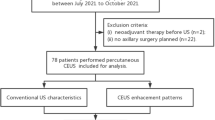Abstract
Background
In cases of thoracic esophageal cancer, multidirectional lymphatic flow from the tumor means that lymph node metastasis can occur in an area extending from the neck to the abdomen. To validate a method for limiting the performance of three-field lymphadenectomy only to patients who need it, we carried out a prospective study in which superparamagnetic iron oxide (SPIO)-enhanced lymphatic mapping was used to determine whether to perform neck lymph node dissection in patients with submucosal thoracic esophageal cancer.
Methods
A total of 22 patients with clinically submucosal thoracic squamous cell esophageal cancer, without neck lymph node metastasis, were enrolled. SPIO was endoscopically injected into the peritumoral submucosal layer, after which its appearance in lymph nodes in the neck was evaluated using magnetic resonance imaging (MRI). Neck lymph nodes were then dissected based on the SPIO-enhanced MRI lymphatic mapping.
Results
Influx of SPIO into lymph nodes was detected in 21 patients (95% detection rate). SPIO flowed to the neck in 8 (36%) patients. Influx of SPIO into neck lymph nodes was unilateral in five patients and bilateral in three patients, and the lymph nodes were dissected accordingly. A cancer-involved node was identified in two of those patients. In 14 patients, we did not dissect neck nodes. Patients were followed up for 6 to 47 months. The neck lymph node recurrence rate was zero, and the overall recurrence rate was 5%.
Conclusions
SPIO-enhanced lymphatic mapping may be useful for estimating the need for three-field lymphadenectomy with neck dissection.


Similar content being viewed by others
References
Shimada H, Okazumi S, Matsubara H et al (2006) Impact of the number and extent of positive lymph nodes in 200 patients with thoracic esophageal squamous cell carcinoma after three-field lymph node dissection. World J Surg 30:1441–1449. doi:10.1007/s00268-005-0462-6
Xu QR, Zhuge XP, Zhang HL et al (2011) The N-classification for esophageal cancer staging: should it be based on number, distance, or extent of the lymph node metastasis? World J Surg 35:1303–1310. doi:10.1007/s00268-011-1015-9
Jamieson GG, Thompson SK (2009) Detection of lymph node metastases in oesophageal cancer. Br J Surg 96:21–25
Tsurumaru M, Kajiyama Y, Udagawa H et al (2001) Outcomes of extended lymph node dissection for squamous cell carcinoma of the thoracic esophagus. Ann Thorac Cardiovasc Surg 7:325–329
Igaki H, Tachimori Y, Kato H (2004) Improved survival for patients with upper and/or middle mediastinal lymph node metastasis of squamous cell carcinoma of the lower thoracic esophagus treated with 3-field dissection. Ann Surg 239:483–490
Law S, Wong J (2001) Two-field dissection is enough for esophageal cancer. Dis Esophagus 14:98–103
Pennathur A, Zhang J, Chen H et al (2010) The “best operation” for esophageal cancer? Ann Thorac Surg 89:S2163–S2167
Altorki NK (2006) Lymph node dissection for carcinoma of the esophagus, In: Difficult Decisions in Thoracic Surgery: An Evidence-based Approach. Springer-Verlag, London, pp 225–233
Motoyama S, Ishiyama K, Maruyama K et al (2007) Preoperative mapping of lymphatic drainage from the tumor using ferumoxide-enhanced magnetic resonance imaging in clinical submucosal thoracic squamous cell esophageal cancer. Surgery 141:736–747
Ishiyama K, Motoyama S, Tomura N et al (2006) Visualization of lymphatic basin from the tumor using magnetic resonance lymphography with superparamagnetic iron oxide in patients with thoracic esophageal cancer. J Comput Assist Tomogr 30:270–275
Saini S, Stark DD, Hahn PF et al (1987) Ferrite particles: a superparamagnetic MR contrast agent for the reticuloendothelial system. Radiology 162:211–216
Motoyama S, Saito R, Kitamura M et al (2003) Outcome of active surgery during intensive follow-up for second primary malignancy after esophagectomy for thoracic squamous cell esophageal carcinoma. J Am Coll Surg 197:914–920
Japan Society for Esophageal Diseases (2004) Guidelines for clinical and pathologic studies on carcinoma of the esophagus, ninth edition: preface, general principles, part I. Esophagus 1:61–88
Ando N, Ozawa S, Kitagawa Y et al (2000) Improvement in the results of surgical treatment of advanced squamous esophageal carcinoma during 15 consecutive years. Ann Surg 232:225–232
Motoyama S, Maruyama K, Sato Y et al (2009) Status of involved lymph nodes and direction of metastatic lymphatic flow between submucosal and T2–4 thoracic squamous cell esophageal cancers. World J Surg 33:512–517. doi:10.1007/s00268-008-9781-8
Morton DL, Wen DR, Wong JH et al (1992) Technical details of intraoperative lymphatic mapping for early stage melanoma. Arch Surg 127:392–399
Kitagawa Y, Fujii H, Mukai M et al (2002) Intraoperative lymphatic mapping and sentinel lymph node sampling in esophageal and gastric cancer. Surg Oncol Clin N Am 11:293–304
Takeuchi H, Fujii H, Ando N et al (2009) Validation study of radio-guided sentinel lymph node navigation in esophageal cancer. Ann Surg 249:757–763
Imano H, Motoyama S, Saito R et al (2004) Superior mediastinal and neck lymphatic mapping in mid- and lower-thoracic esophageal cancer as defined by ferumoxide-enhanced magnetic resonance imaging. Jpn J Thorac Cardiovasc Surg 52:445–450
Hironaka S, Ohtsu A, Boku N et al (2003) Nonrandomized comparison between definitive chemoradiotherapy and radical surgery in patients with T(2–3)N(any)M(0) squamous cell carcinoma of the esophagus. Int J Radiat Oncol Biol Phys 57:425–433
Author information
Authors and Affiliations
Corresponding author
Rights and permissions
About this article
Cite this article
Motoyama, S., Ishiyama, K., Maruyama, K. et al. Estimating the Need for Neck Lymphadenectomy in Submucosal Esophageal Cancer Using Superparamagnetic Iron Oxide-Enhanced Magnetic Resonance Imaging: Clinical Validation Study. World J Surg 36, 83–89 (2012). https://doi.org/10.1007/s00268-011-1322-1
Published:
Issue Date:
DOI: https://doi.org/10.1007/s00268-011-1322-1




